Artillery in Canada (7) New Brunswick: Fredericton, Grand Anse, Grand Falls, Hopewell Cape, Kedgwick, Keswick Ridge, Maces Bay, Minto, Miramichi, Moncton and New Maryland
Artillery preserved in New Brunswick
Artillerie préservée au Nouveau-Brunswick
Fredericton, Grand Anse, Grand Falls, Hopewell Cape, Kedgwick, Keswick Ridge, Maces Bay, Minto, Miramichi, Moncton, and New Maryland
The aim of this website is to locate, identify and document every historical piece of artillery preserved in Canada. Many contributors have assisted in the hunt for these guns to provide and update the data found on these web pages. Photos are by the author unless otherwise credited. Any errors found here are by the author, and any additions, corrections or amendments to this list of Guns and Artillery in Canada would be most welcome and may be e-mailed to the author at [email protected].
For all official data concerning the Royal Regiment of Canadian Artillery, please click on the link to their website:
Royal Regiment of Canadian Artillery Website
Note: Back in the day, artillery in Canada was referred to by its radio call sign "Sheldrake". It is now referred to by its "Golf" call sign. (Acorn sends)
Une traduction au français pour l'information technique présente serait grandement apprécié. Vos corrections, changements et suggestions sont les bienvenus, et peuvent être envoyés au [email protected].
New Brunswick
Fredericton Region Museum, Officer's Square
.webp)
.webp)
(Author Photos)
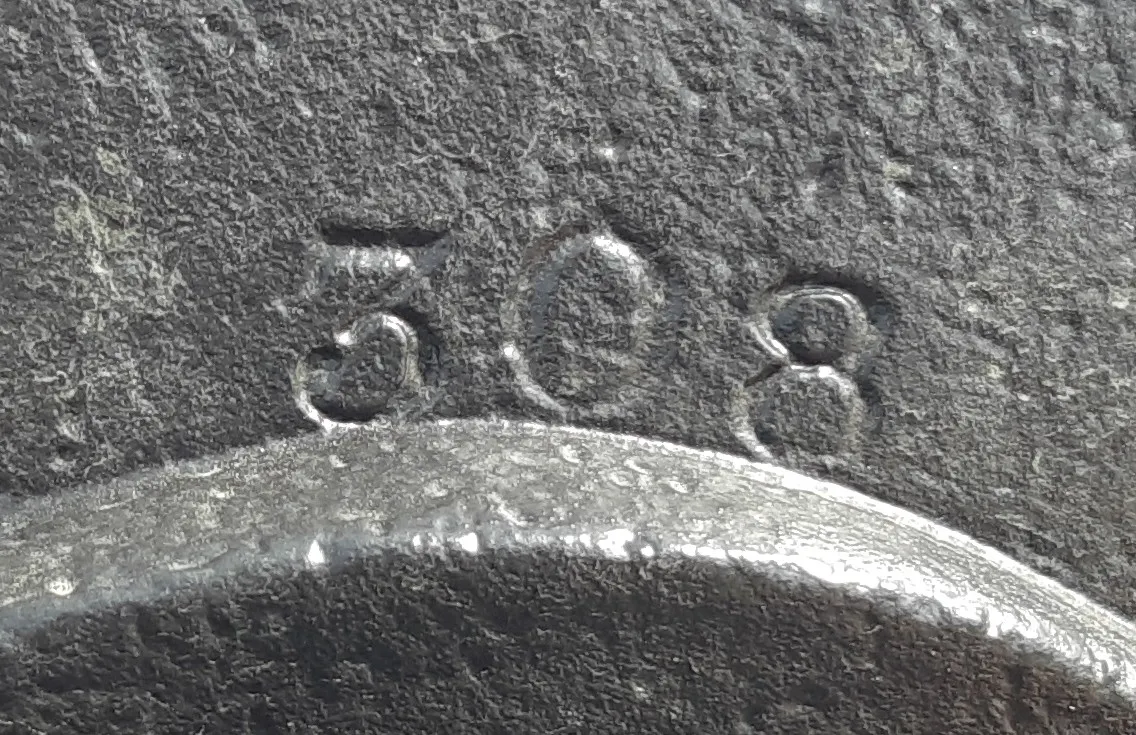
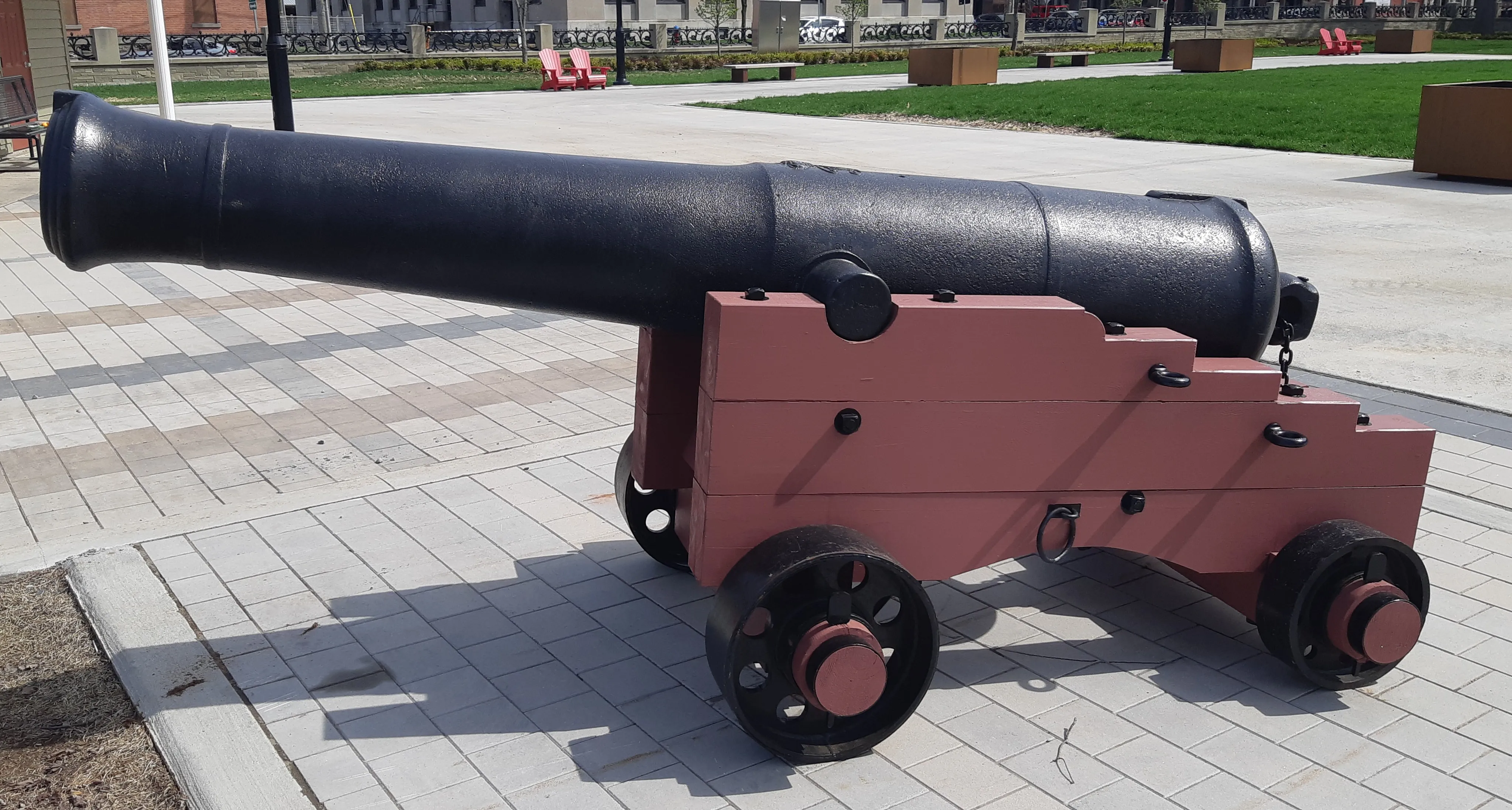
(Author Photos)
Cast Iron 64-pounder 71-cwt Muzzleloading Rifle (MLR) with a Dundas or Millar pattern breeching ring, Palliser conversion from a 32-pounder 58-cwt smoothbore muzzle-loading (SBML) Gun to a rifled muzzle-loading (RML) 32-pounder Gun, Queen Victoria cypher, broad arrow, Royal Gun Factory (RGF), (Serial No. 308) with an I ,over possibly a corroded 1856 on the left trunnion, blank on the right trunnion, weight 58-0 (6,596 lbs). RGF IRON on the muzzle. No. 2 of 2 that will stand again in Officer’s Square, facing the lighthouse on the Saint John River, opposite the York-Sunbury historical Society, Fredericton Region Museum. This gun came from Halifax ca. 1947. It has been sanded and repainted for preservation with the City of Fredericton Operations Department.
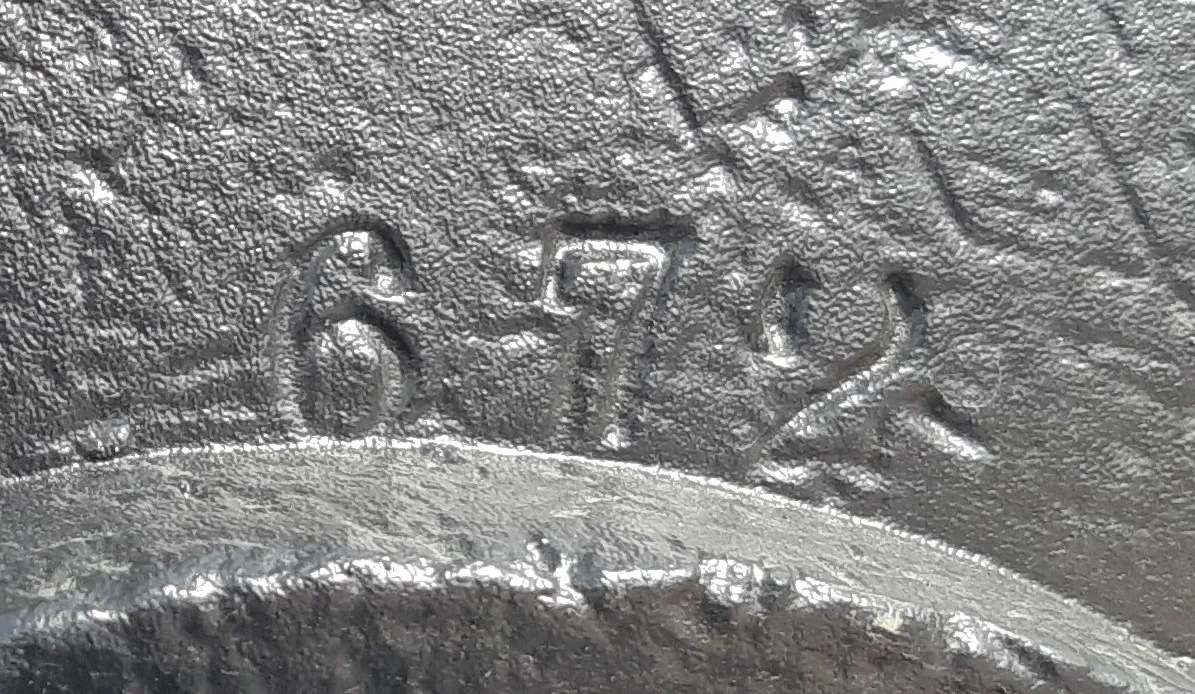

(Author Photos)
Cast Iron 64-pounder 71-cwt Muzzleloading Rifle (MLR) with a Dundas or Millar pattern breeching ring, Palliser conversion from a 32-pounder 58-cwt smoothbore muzzle-loading (SBML) Gun to a rifled muzzle-loading (RML) 32-pounder Gun, Queen Victoria cypher, broad arrow, Royal Gun Factory (RGF), (Serial No. 672) with an I ,over possibly a corroded 1856 on the left trunnion, blank on the right trunnion, weight 59-0 (6,608 lbs). RGF IRON on the muzzle. No. 1 of 2 that will stand again in Officer’s Square, facing the lighthouse on the Saint John River, opposite the York-Sunbury historical Society, Fredericton Region Museum. This gun came from Halifax ca. 1947. It has been sanded and repainted for preservation with the City of Fredericton Operations Department.
.avif)
(Author Photo)
The City of Fredericton, New Brunswick has cleaned and painted the two cannon shown here that have stood in front of the Fredericton Region Museum since 1947. This made it possible to read the serial numbers and weight information that had been nearly invisible under many previous coats of paint!
Fredericton Region Museum’s two Palliser conversion 64-pounder Muzzleloading Rifles
The cast-iron 32-pounder smoothbore muzzleloading (SBML) gun was the standard broadside gun on ships of the line of Royal Navy battle ships in the 18th and 19thcentury. The most common of these guns found in Canada are the weapons designed by Thomas Blomefield in the late 1780s or 1790s. Made by the Walker & Company of Rotherham, Yorkshire, England, and Carron of Falkirk, Scotland, these were excellent guns. The development of armour-plated steamships, however, meant that there was a need for heavier, longer-ranging weapons to be mounted in shore batteries and on warships. Lieutenant-Colonel William Dundas, who was Britain’s Inspector of Artillery from 1839 to 1852, designed two new 32-pounders which were part of the new armament accepted into Britain’s naval service.
When Britain adopted rifled ordnance in the 1860s it still had large stocks of serviceable but now obsolete smoothbore guns. Gun barrels were expensive to manufacture, so the best and most recent models were selected for conversion to rifled guns, for use as second-line ordnance, using a technique designed by Major William Palliser. The Palliser conversion was based on what was accepted as a sound principle that the strongest material in the barrel construction should be innermost, and hence a new tube of stronger wrought iron was inserted in the old cast iron barrel, rather than attempting to reinforce the old barrel from the outside.
This gun was based on the cast-iron barrel of the Millar Pattern 8-inch 65 cwt gun, originally designed in 1834. This gun was designed to fire a smooth bore spherical shell weighing 50 pounds. The 8-inch gun was bored out to 10.5 inches and a new built-up wrought iron inner tube with an inner diameter of 6.29 inches was inserted and fastened in place. The gun was then rifled with 3 grooves, with a uniform twist of 1 turn in 40 calibres (i.e. 1 turn in 252 inches), and proof fired. The proof firing also served to expand the new tube slightly and ensure a tight fit in the old iron tube.
These rifled guns were initially issued for Sea Service (SS), but by 1886 were obsolete in that role and were being returned to store for re-issue for Land Service (LS). In Naval service they were deployed on many smaller British cruising warships around the world.
In Land service many were mounted for coast defence in both British and colonial locations. They were mounted on a wide variety of iron and wooden carriages. They became obsolete for coast artillery use in 1902, whereupon most of them were scrapped and disposed of.
A Cast Iron 64-pounder 71-cwt Muzzleloading Rifle (MLR) with a Dundas or Millar pattern breeching ring, Palliser conversion from a 32-pounder 58-cwt SBML, weighed over 6,400lbs. Most had been cast as 32-pounders between 1853 and 1856. The Palliser modification with the guns being re-bored to 64-pounder, took place between 1868 and 1871.
.avif)
.avif)
.avif)
.avif)
.avif)



(Author Photos)
Cast Iron 64-pounder 71-cwt Muzzleloading Rifle (MLR) with a Dundas or Millar pattern breeching ring, Palliser conversion from a 32-pounder 58-cwt smoothbore muzzle-loading (SBML) Gun to a rifled muzzle-loading (RML) 32-pounder Gun, Queen Victoria cypher, broad arrow, Royal Gun Factory (RGF), (Serial No. 672) with an I, over possibly a corroded 1856 on the left trunnion, blank on the right trunnion, weight 59-0 (6,608 lbs). RGF IRON on the muzzle. No. 1 of 2 that will stand again in Officer’s Square, facing the lighthouse on the Saint John River, opposite the York-Sunbury historical Society, Fredericton Region Museum. This gun came from Halifax ca. 1947. It has been sanded and repainted for preservation with the City of Fredericton Operations Department.
.avif)
.avif)
.avif)


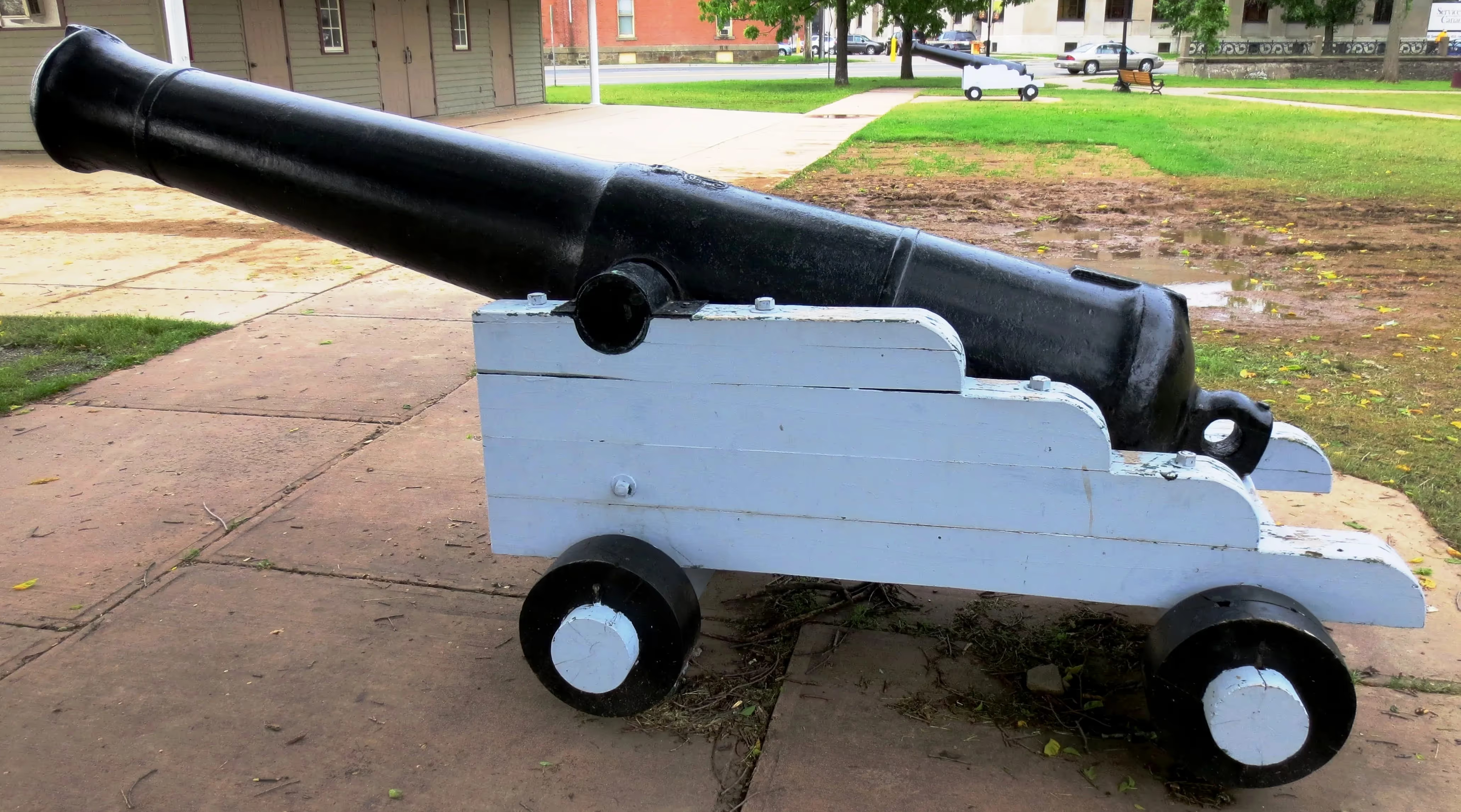
(Author Photos)
Cast Iron 64-pounder 71-cwt Muzzleloading Rifle (MLR) with a Dundas or Millar pattern breeching ring, Palliser conversion from a 32-pounder 58-cwt smoothbore muzzle-loading (SBML) Gun to a rifled muzzle-loading (RML) 32-pounder Gun, Queen Victoria cypher, broad arrow, Royal Gun Factory (RGF), (Serial No. 308) with an I, over possibly a corroded 1856 on the left trunnion, blank on the right trunnion, weight 58-0 (6,596 lbs). RGF IRON on the muzzle. No. 2 of 2 that will stand again in Officer’s Square, facing the lighthouse on the Saint John River, opposite the York-Sunbury historical Society, Fredericton Region Museum. This gun came from Halifax ca. 1947. It has been sanded and repainted for preservation with the City of Fredericton Operations Department.

(Author Photo)
Cast Iron ½-pounder Smoothbore Muzzleloading Gun, heavily corroded, no markings visible, mounted on a wooden carriage. This gun is recorded as having come from Fort Jemseg and was on display inside the Fredericton Region Museum on Officer’s Square. Gift from Mrs Goodrich Sloat, 1969. It is currently on loan to the New Brunswick Military History Museum at 5 Division Area Support Base Gagetown.


(Author Photos)
German First World War 7.92-mm Maxim Spandau MG 08/15 Machinegun, (Serial Nr. 6209a), Gwf Spandau 1917. This weapon was likely captured ca 1918 by a Battalion of an Infantry Brigade in a Canadian Division of the Canadian Expeditionary Force (CEF), in France. This MG is on display inside the Fredericton Regional Museum on Officer’s Square.

(Author Photo)
German First World War 7.92-mm Maxim Spandau MG 08 Machinegun, (Serial Nr. 5923). This gun was captured on 28 Aug 1918 by a Battalion of an Infantry Brigade in the 2nd Canadian Division of the Canadian Expeditionary Force (CEF), in France. This MG 08 was originally allocated to Fredericton. The weapon is mounted in a Great War exhibit inside the Fredericton Regional Museum on Officer’s Square.
Fredericton, Royal Canadian Legion Branch No. 4

(Author Photo)
6-pounder 7-cwt QF Anti-Tank Gun, painted with a white No. 46 on a blue over red tactical sign on the face of the shield, with the Second World War formation markings of the 90th Battery. No. 1 in front of the Royal Canadian Legion, Branch No. 4.

(Author Photo)
6-pounder 7-cwt QF Anti-Tank Gun, painted with a white No. 2 on a grey, white, blue and red tactical sign on the face of the shield, with the Second World War formation markings of the 104th Battery. No. 2 in front of the Royal Canadian Legion, Branch No. 4.
.webp)
.webp)
.webp)
.webp)
(Author Photos)
As of May 2025, the two 6-pounder 7-cwt QF Anti-Tank Guns that stood in front of the Royal Canadian Legion, Branch No. 4 in Fredericton, are undergoing restoration at the Base Maintenance HQ at 5 CDSB Gagetown and will be returned to the legion soon.
90th Anti-tank Battery, 1st Anti-Tank Regiment, RCA.
The 90th Anti-Tank Battery, RCA, was raised in Fredericton and landed in Sicily on 10 July 1943, followed by landing in Italy, on 5 September 1943. There they served until leaving Italy on 9 March 1945, bound for North-West Europe, where they resumed operations on 11 April 1945, in The Netherlands. They served here until the cessation of hostilities in North-West Europe, on 5 May 1945. The 90th Anti-Tank Battery, RCA, was a component battery of the 1st Anti-Tank Regiment, RCA, of the 1st Canadian Infantry Division, from 1 December 1939, to the disbandment of 1st Anti-Tank Regiment, RCA, on 28 August 1945. (War Diaries, 1st Anti-Tank Regiment, RCA, Library and Archives Canada (Ottawa), reference: RG24, National Defence, Series C-3, Volumes: 14553, 14554, 14555, and 14556, covering the period from September 1939 to August 1945.)
104th Anti-tank Battery, 7th Anti-tank Regiment, RCA.
The 104th Battery was mobilized in Fredericton, York County, New Brunswick on 15 July 1940 with Major W. F. Blair as O.C. Other officers included, Capt. E.D. Hall, Lieut. Y. McLean, Lieut. T.K. Stephens, Lieut. D.A. Wolstenholme, and Lieut. R.M. McGibbon. The new recruits received basic training at the experimental farm, located near Fredericton, following which they were shipped to Nickel Building, in Kingston, Ontario, and then on to Petawawa at the end of November 1940. At this time, the 104th Battery came under the command of the 4th Anti-Tank Regiment Royal Canadian Artillery.
In March 1941, the 104th Battery was moved to St. Stephen, New Brunswick. The following month, it embarked at Halifax, Nova Scotia, aboard the H.M.T. "Georgic", as an independent battery, destined for Gourock, Scotland. In Scotland the recruits received more anti-tank training. The 104th Anti-Tank Battery became a component of the 7th Anti-Tank Regiment RCA that was formed in England on 25 July 1941 to serve as 1st Canadian Corps Anti-Tank Regiment.
The 104th Battery boarded the "Scythia," on 12 November 1943, at Bristol, England, bound for the Mediterranean on operation "Timberwolf II". By 25 November 1943, the 104th had disembarked at Algiers, Algeria, North Africa. It later moved on to Sicily, France, and Holland. The Battery served in Holland under First Canadian Army until the Second World War ended. It disbanded in June 1945. (Provincial Archives of New Brunswick)
Fredericton, Marysville

(Author Photo)
6-pounder 7-cwt QF Anti-Tank Gun, painted with a white No. 2 on a red over blue tactical sign on the face of the gun shield. Marysville Cenotaph.
Fredericton Military Compound, Historic Garrison District
A British garrison post (1785 - 1869, 1883 - 1914), occupying a two block area bounded by the river and Queen, York and Regent Streets. British troops left in 1869. Constructed mainly of wood, most of the original buildings were lost through deterioration or fire; however, a number of the key buildings were rebuilt with stone. One original wooden building and three 19th-century stone structures remain. The present-day Justice Building (1929) is on the site of the old Military Hospital (1827 - 1875). In 1965 the Military Compound was declared a National Historic Site.
The Military Compound is designated a Provincial Historic Site for being a 2 block area that has evolved from a military establishment to accommodating a variety of federal, provincial and municipal institutions for over a period of more than 200 years. The Military Compound is designated for its association with the military history of New Brunswick. With the arrival of the Loyalists after the American Revolution, Fredericton was made the capital of the new colony of New Brunswick in 1784. British military were stationed in the Military Compound to protect the new colony from invasion overland along the American border. The British military remained on the site until 1869. The Canadian government continued military activities at the Military Compound. A Drill Hall was constructed in 1885 which is still in use by the Canadian military.
Discovered archaeological resources reflect the use of this site as a military compound, while their is a strong potential for yet-to-be discovered resources. The heritage value of the site also resides in its historic and continued use by the three levels of governement. The federal government also maintained offices on the site which resulted in two post office buildings being constructed on the east block in 1882 and 1913. On the west block, the Province of New Brunswick first constructed a Normal School in 1876, which was rebuilt in 1930 and is now the provincial Justice Building. Later the province constructed a Liquor Commission Building, which is now occupied by the New Brunswick College of Craft and Design. The Fredericton Public Library and York Regional Library occupy the newest building on the site, constructed in 1975. The Military Compound is now a centre for cultural activities in the city - with the library, New Brunswick College of Craft and Design, several museums, a statue of Lord Beaverbrook and open spaces for cultural events.
Militia Arms Store (1832): Of the 61 original buildings in the compound, this is the only remaining wooden structure. It was used to store weapons and ammunition for the local militia. In 1882 an extension was added to the rear and renovated into a military hospital. It has seen several uses since then, a warehouse, temperance hall, a caretaker's residence, and offices for the Downtown Development Fredericton Inc. Located on Carleton Street, it now houses the city's tourism staff.
Guard House (1828): This small building is typical of British guard houses found around the world. It consists of an orderly room, guard room and detention cells. It has been restored to the 1866 period with muskets, uniforms and equipment, when the British 15th Regiment was stationed here. Located on Carleton Street, there is a Historic Sites and Monuments Board of Canada plaque on the building.
Officers' Quarters (1841): The original quarters for the British officers of the garrison was a wood and brick structure completed in 1792, which was destroyed by fire in 1815, and then was rebuilt in a similar style. The existing stone structure was added in two sections, one in 1841 and the other 1851, each separated by a brick firewall. The wooden sections of the building were removed in 1925; however, the outline of its stone foundation is still visible. Located on Officers' Square, the Officers' Quarters currently host the Fredericton Region Museum, administered by the York-Sunbury Historical Society.
Soldiers' Barracks (1827): The original wooden barracks were replaced by the existing stone structure in November 1827. It was occupied by British troops from then until their departure in 1869. Then it was used as a Provincial Normal School and by other local organizations until 1883 when the newly formed Infantry School Corps, a part of the Canadian Army, returned it back to a barracks. After the First World War it fell into disuse until 1927 when it became a warehouse. In 1974 one barrack room was restored to illustrate its original use and the remainder of the building became the home of the Province's Archaeology Branch and its collection. Located on Queen Street.
Fredericton, Fort Nashwaak
A French palisaded four-bastioned fort (1692-1698), located on the north bank of the Nashwaak River at its mouth. Also spelled Naxouat. Also known as Fort St. Joseph, as it was built by Acadian Governor Joseph Robinou de Villebon to replace Fort Jemseg as the military headquarters of Acadia. Repelled a British attack in October 1697. British siege works were located on the south bank of the river, near the present-day Fort Nashwaak Motel. A Historic Sites and Monuments Board of Canada plaque in Carleton Park commemorates the fort. The actual site is now an Irving Oil tank farm.
Fredericton Junction Blockhouse
A British blockhouse (1812-1815) built at what was known as Hartt's Mills, to guard the Oromocto River portage route between the Saint John River and the Maguadavic River. A house was built on the site of the blockhouse in 1922. There are four old graves in the Gladstone Cemetery on Prides Landing Road, and are believed to be those of members of the blockhouse garrison who died there while on duty.
Village of Gagetown, Royal Canadian Legion Branch No. 71
German First World War 7.92-mm Maxim Spandau MG 08/15 Machinegun, (Serial Nr. 4359). This weapon was captured on 9 Aug 1918 by the 5th Battalion (Western Cavalry, 2nd Infantry Brigade, 1st Canadian Division, Canadian Expeditionary Force (CEF), near Warvillers, France. The MG 08/15 is preserved inside the Alfred Ashburn Memorial Legion Branch No. 71, 81 Tilley Road.
Gagetown Blockhouse
A former fur trade post where ammunition and guns were stored (1761). A private craft business is here now on Loomcroft Lane, facing Gagetown Creek.
Grand-Anse

(Author Photo)
American 90-mm M1A1 Anti-Aircraft Gun (Serial No. 3775), Community Park between Highway 11 and the Bay of Chaleur.


(Author Photos)
4-inch/40 QF Mk. XXI Gun on the High Angle Single Mk XXIV Mounting, SIL 1945, No. S/14729. Community Park.
Grand Falls

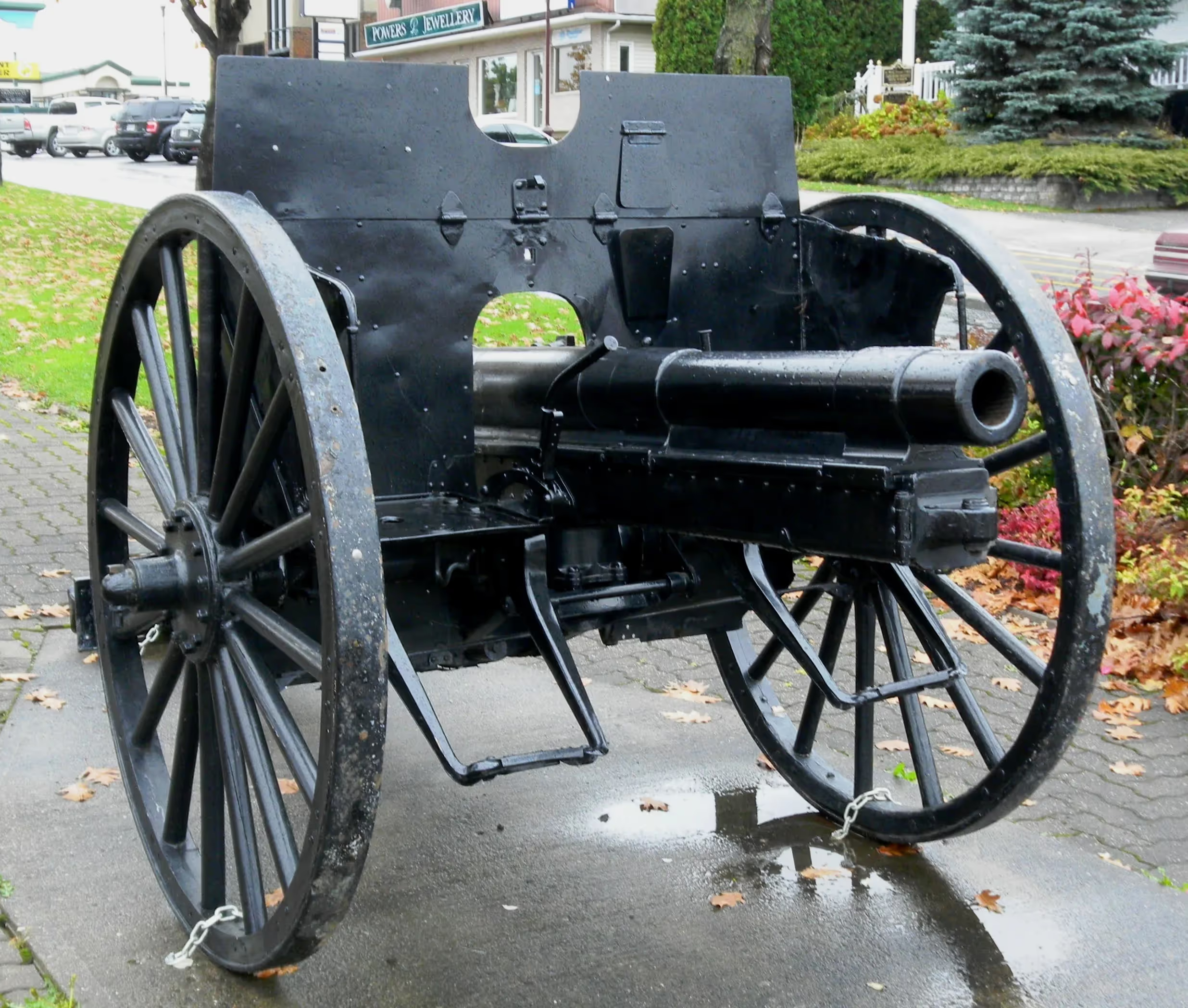


(Author Photos)
German First World War 7.7-cm Feldkanone 96 neuer Art (7.7-cm FK 96 n.A.), (Serial Nr. 8283). This FK 96 was captured on 27 Aug 1918 by the 25th Battalion (Nova Scotia Rifles), 5th Infantry Brigade, 2nd Canadian Division, Canadian Expeditionary Force (CEF), at Moon Quarry near Cherisy, France. Main Street, City Park.
Hopewell Cape



(Author Photos)
German First World War 7.7-cm Feldkanone 96 neuer Art (7.7-cm FK 96 n.A.), (Serial Nr. 784), no data. This FK 96 was likely captured ca 1918 by a Battalion of an Infantry Brigade in a Canadian Division of the Canadian Expeditionary Force (CEF), in France.



(Author Photos)
German First World War 10-cm Kanone 14 (10-cm K 14), (Serial Nr. 590), 1917. This rare K 14 was captured on 9 April 1917 by the 27th Battalion (City of Winnipeg), 6th Infantry Brigade, 2nd Canadian Division, Canadian Expeditionary Force (CEF), at Farbus near Vimy, France.
A plaque fixed to the gun states, “This German Gun No. 590 captured in the World War by the 26th Battalion recruited in this province was won by the citizens of Albert County, New Brunswick in the Victory Loan competition of 1919. Henry L. Drayton, Minister of Finance.”
The 26th Canadian Battalion, Canadian Expeditionary Force (also known as the 26th (New Brunswick) Battalion, CEF) was composed of volunteers from the province of New Brunswick, Nova Scotia, Prince Edward Island and the Gaspé Peninsula. This unit was authorized on 7 November 1914 and embarked for Britain on 15 June 1915. It arrived in France on 16 September 1915, where it fought as part of the 5th Infantry Brigade, Second Canadian Division in France and Flanders until the end of the First World War. It participated in all of the major battles in which the Canadian Corps was involved. The battalion was disbanded on 30 August 1920. The battle honours for the 26th (New Brunswick) Battalion, CEF are held by the Royal New Brunswick Regiment.
Kars, Worden's Ferry Battery and Blockhouse
A British blockhouse (1813-1815), was built on the crest of a 200-foot high hill, and a three-gun earthwork battery and magazine commanding the river, to be used as a place of refuge and defence if Saint John were to be captured. The site was also known as the "Eagle's Nest". It was reported to be in ruin by 1825. During the French period the location was known as "Nid d'Aigle", and local tradition holds that a French military post was located at this strategic spot. No evidence has yet been found, however, to support this claim.
Kedgwick


(Author Photos)
155-mm C1 (M1A2) Medium Howitzer on M1A2 Carriage, aka M114, manufactured at Sorel Industries Limited in Quebec, Queen Elizabeth II cypher. CFR 34-448. The carriage plate reads: CARR. HOW. 155MM M1A2 CDN. SOREL INDUSTRIES LTD. CANADA (year TBC), REG. NO. CDN 171, INSP (symbol). The breech block reads: HOWITZER 155MM M1A1 CDN, CANADA, SOREL INDUSTRIES LTD, 1956, 3730 LBS, INSP (symbol). Veterans Memorial, Highway 17. The breech block reads: HOWITZER 155MM M1A1 CDN, CANADA, SOREL INDUSTRIES LTD, 1956, 3730 LBS, INSP (symbol). The carriage plate reads: CARR HOW 155mm M1A2 CDN, SOREL INDUSTRIES LTD, CANADA (year TBC), REG. NO. CDN 171, INSP (Symbol). The CFR number painted on the right trail is 0034448.


(Library and Archives Canada Photo, MIKAN No. 4314245)
Cypher, and portrait of Queen Elizabeth II, reigning from 6 Feb 1952 to present.
Keswick Ridge
.avif)
.avif)
.avif)
.avif)
.avif)
.avif)
(Author Photos)
It is a 9-pounder 8-cwt Muzzleloading Rifle, weight 8-1-13 (937 lbs), Queen Victoria cypher, Sir W.G. Armstrong and Co., No. 285, Newcastle on the Tyne on the left trunnion. 9-pounders like this gun were used in the North West Rebellion in 1885. This gun was previously located at Maces Bay. It now stands outside the Keswick Ridge Historical Society Museum.
Lower Jemseg, Fort Jemseg
Originally built by British trader Thomas Temple at the mouth of the Jemseg River (1659 - 1674, 1690 - 1692). Also spelled Jemseck. Described as a rectangular palisaded enclosure with walls 18 feet in height and armed with five iron guns mounted on a wooden platform. French troops occupied the post in 1670 per the 1667 Treaty of Breda. Briefly captured by Dutch privateers led by Jurriaen Aernouts in August 1674 and then abandoned. Acadian Governor Joseph Robinou de Villebon temporarily moved the French military headquarters here from Port Royal, NS in 1690. Although there is a Historic Sites and Monuments Board plaque located in Lower Jemseg, the exact location of the fort is unknown, but is believed to be near the Scovil Landing of the Gagetown Ferry.
Meductic
A Maliseet Indian stockaded stronghold dating from the 1600s was located in the Meductic Flat area of the Saint John River, near the mouth of the Eel River. Early European explorers reported finding there a roughly rectangular stockade, constructed of logs bound together with spruce roots and supported by earth and rocks, the whole being surrounded by a defensive trench. Within the stockade was a long house, where councils were held, and facilities for storing provisions. A short distance from the stockade was the village proper. Archaeological excavations of the site occurred in the 1960s. A Historic Sites and Monuments Board of Canada plaque is located nearby along the Trans-Canada Highway. The site, now flooded by the Mactaquac Hydro Dam, is located north of town.
Minto

(Author Photo)
155-mm C1 (M1A2) Medium Howitzer on M1A2 Carriage, aka M114, manufactured at Sorel Industries Limited in Quebec, Queen Elizabeth II cypher. The carriage plate reads: CARR. HOW. 155MM M1A2 CDN. SOREL INDUSTRIES LTD. CANADA (1956), REG. NO. CDN 150, INSP (symbol). The breech block reads: HOWITZER 155MM M1A1 CDN, CANADA, SOREL INDUSTRIES LTD, Date 1956, 3730 LBS, INSP (symbol). Royal Canadian Legion Branch No. 12.



(Author Photos)
155-mm C1 (M1A2) Medium Howitzer on M1A2 Carriage, aka M114, manufactured at Sorel Industries Limited in Quebec, Queen Elizabeth II cypher. The carriage plate reads: CARR. HOW. 155MM M1A2 CDN. SOREL INDUSTRIES LTD. CANADA (1956), REG. NO. CDN 150, INSP (symbol). The breech block reads: HOWITZER 155MM M1A1 CDN, CANADA, SOREL INDUSTRIES LTD, Date 1956, 3730 LBS, INSP (symbol). Royal Canadian Legion Branch No. 12.
Miramichi

(Author Photo)
6-pounder 7-cwt QF Anti-Tank Gun, cenotaph, Elm Park.

(Author Photo)
40-mm Bofors Light Anti-Aircraft Gun, at the cenotaph, Elm Park. No. 1 of 2.

(Author Photo)
40-mm Bofors Light Anti-Aircraft Gun, at the cenotaph, Elm Park. No. 2 of 2.

(Author Photo)
Cast Iron 6-pounder 6-cwt Smoothbore Muzzleloading Carronade with a broken Blomefield pattern breeching ring, beside a city fountain.

(Author Photo)
Cast Iron 12-pounder 6-cwt Smoothbore Muzzleloading Carronade with a Blomefield pattern breeching ring, set on wood blocks on the ground beside a city fountain.
Moncton


(Author Photos)
25-pounder C Mk. 2 QF Field Gun with No. 9 circular firing platform, Victoria Park.

(Author Photo)
90-mm M1A1 Anti-Aircraft Gun, Moncton Armoury.
Cast Iron 12-pounder 6-cwt Smoothbore Muzzleloading Carronade with a Blomefield pattern breeching ring, weight (TBC) mounted on a small concrete naval carriage at Creek Village Park, Pleasant Street. NICMM record # 13008-001.
New Maryland


(Author Photos)
105-mm C1A1 M2A2 Howitzer, Serial No. 4530, Carriage M2A2CDN 1118, CFR 1950-34057, Serial No. 3638, weight 1,060 lbs. Victoria Park. Built in 1950, this Howitzer was retired from services in 2008 and disposed of by Donation/ Deactivation last 11 May 2016. It had most likely been in service with Royal Regiment of Canadian Artillery School at 5 CDSB Gagetown throughout its longevity.





